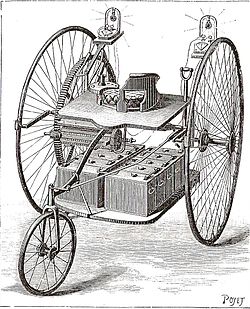Ayrton & Perry Electric Tricycle
| Ayrton & Perry | |
|---|---|
| Electric tricycle | |
| Production period: | 1882 |
| Class : | Light vehicle |
| Body versions : | Phaeton |
| Engines: |
Electric motor : approx. 0.37 kW |
| Length: | |
| Width: | |
| Height: | |
| Wheelbase : | |
| Empty weight : | |
The Ayrton & Perry Electric Tricycle is an electric tricycle . It was built by the two English professors William Edward Ayrton and John Perry a few months after the world's first electric vehicle , the Trouvé Tricycle . In October 1882 they drove with this for the first time on Queen Victoria Street in London.
description
Ayrton and Perry used a tricycle from Howe Machine Company of Glasgow for their electric vehicle. This had two large wheels on the front axle and a small wheel at the rear, the engine had an output of around 0.37 kilowatts, i.e. around 0.5 hp. The traction batteries of Camille Alphonse Faure had a capacity of one kilowatt-hour and a voltage of 20 volts. In some cases, cells from Sellon-Volckmar were also used. The accumulators were arranged on a board under the bench.
The speed was regulated by switching the ten battery cells on and off individually. This vehicle had a range of up to 40 kilometers and reached a top speed of around 14 km / h. In addition, unlike Trouvès' vehicle, it no longer had any pedals and was therefore completely dependent on the electric drive. The Ayrton & Perry Tricycle is the first vehicle with electric light.
The reconstruction from 2011
The foundation board of the Museum Autovision , Horst Schultz , made it his task with his museum workshop team to rebuild the Ayrton & Perry Electric Tricycle, of which the original apparently no longer exists, ready to drive. This reconstruction is exhibited in the Autovision Museum.
Web links
Individual evidence
- ^ A b The Telegraph Journal and Electrical Review on October 28, 1882
- ^ The Wheelman Vol II , April-September 1883
- ^ The electric car: development and future of battery, hybrid and fuel-cell cars by Michael Hereward Westbrook, Institution of Electrical Engineers, Society of Automotive Engineers
- ^ Museum Autovision: The world's first electric car drives again , 2011.


